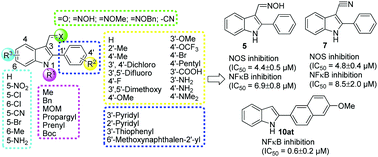Synthesis of 2-arylindole derivatives and evaluation as nitric oxide synthase and NFκB inhibitors†
Abstract
Development of small molecule

* Corresponding authors
a
Department of Pharmaceutical Sciences, College of Pharmacy, University of Hawai'i at Hilo, Hilo, HI, USA
E-mail:
dianqing@hawaii.edu
Fax: +1 808 933 2974
Tel: +1 808 933 2960
Development of small molecule

 Please wait while we load your content...
Something went wrong. Try again?
Please wait while we load your content...
Something went wrong. Try again?
X. Yu, E. Park, T. P. Kondratyuk, J. M. Pezzuto and D. Sun, Org. Biomol. Chem., 2012, 10, 8835 DOI: 10.1039/C2OB26456K
To request permission to reproduce material from this article, please go to the Copyright Clearance Center request page.
If you are an author contributing to an RSC publication, you do not need to request permission provided correct acknowledgement is given.
If you are the author of this article, you do not need to request permission to reproduce figures and diagrams provided correct acknowledgement is given. If you want to reproduce the whole article in a third-party publication (excluding your thesis/dissertation for which permission is not required) please go to the Copyright Clearance Center request page.
Read more about how to correctly acknowledge RSC content.
 Fetching data from CrossRef.
Fetching data from CrossRef.
This may take some time to load.
Loading related content
